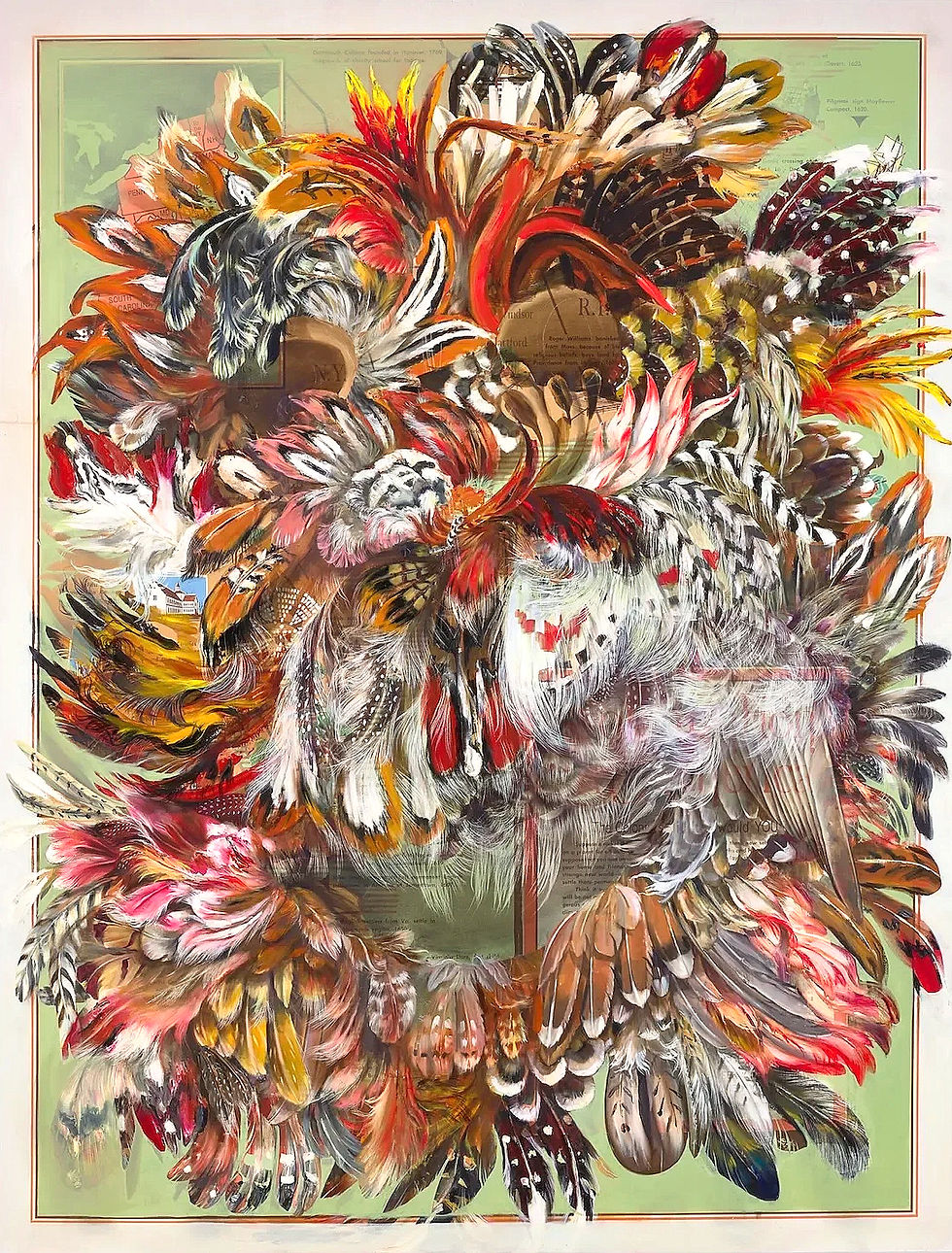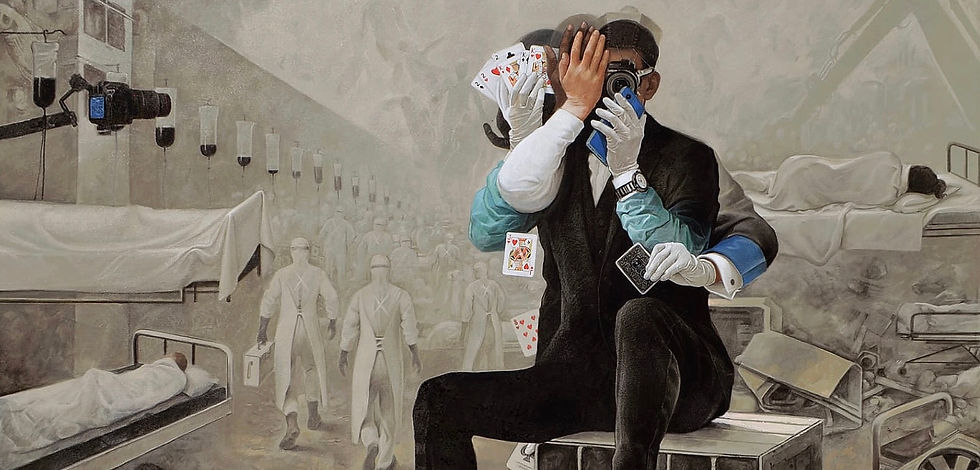“Sueños y Verticalidades” del escultor Alban Lanore y el pintor Pierre Monestier / Embajada de Franc
- Anne Malherbe
- 19 jun 2019
- 7 Min. de lectura

Organizada por la Embajada de Francia se inaugura la exposición “Sueños y Verticalidades” del escultor Alban Lanore y el pintor Pierre Monestier, el 19 de junio 2019, en la zona colonial. a las 8:00 PM. Santo Domingo, RD.
Alban Lanore
Desde las formas de la naturaleza a la naturaleza de las formas: autodidacta a la escultura, Alban Lanore se apasiona, durante sus viajes a Gabón y a Guyana Francesa en la selva Amazónica, por la extraordinaria diversidad de formas creadas por la naturaleza en el camino del “naturalismo integral” defendido por su amigo el escultor brasileño Frans Krajcberg.
Crea increíbles esculturas de plantas (maderas muertas, lianas, tocones, raíces). A lo largo de los años, su trabajo orgánico ha sido refinado y sus últimas esculturas “abstracciones geométricas”, formas radicales talladas en porciones de tronco en bruto y luego quemadas en oposición a madera pulida, inauguran una estética cercana al arte construido mientras permanece personal.
Quien habla mejor de Alban Lanore, es probablemente el famoso escultor francés y vicepresidente de la Academia de Bellas Artes de la República Francesa: Jean Anguera
“Hablar de escultura es fácil si solamente consiste en su descripción. Al describirlo descubrimos quién lo hizo. Sin duda, lo hizo con su fuerza, con lo que es físicamente, pero especialmente con los componentes de su mente, con las formas en que su pensamiento se encuentra con la realidad, una realidad tanto interna como externa.
La escultura de Alban Lanore se basa en la aplicación de la fuerza humana a la dulzura carnal de la madera, la aplicación de la decisión y la velocidad mecánica de la herramienta al sueño silencioso y la lentitud interna del material orgánico. Es indudable que Alban Lanore asocia en él, dos naturalezas: la abstracta y la racional de una mente recta que encuentra su expresión en la vanguardia del acero, en la radicalidad del metal y la naturaleza imaginativa similar a la flexibilidad melancólica, pero secretamente resuelta, de la madera.
En su escultura, estos dos personajes se expresan al oponerse, y sin conciliarse, formando una estética de contraste. El “futuro” de la madera experimenta los sólidos colores y ángulos impuestos por el escultor. Se moldea a sí mismo dentro de las formas y, sin embargo, más allá de las interrupciones, cambios abruptos, más allá de los bordes claros, extiende su curso original.
Alban Lanore es alto, fuerte, ciertamente valiente. Frente a su obra, a los gustos que componen su escultura, a la oposición de sus especificidades, permanece libre, ya que asume plenamente la elección de sus formas y su material. ¡Y su libertad es hermosa de ver! “
Pierre Monestier y la “mise-en-abyme” de las formas.
Observar un dibujo o una pintura de Pierre Monestier, es entrar en un mundo donde reina la forma. De inmediato, estamos tentados a formularnos miles de preguntas sobre la narración supuesta de las imágenes, sobre el sentido de cada motivo o sobre lo que puede impulsar a un pintor a elaborar composiciones tan singulares.Sin embargo, se debe considerar antes todo esto: la manera de la cual las formas se anidan, se prolongan unas a otras, se engendran mutuamente.Cada composición tiene de hecho su lógica, que es tan igual a la de la forma como a la del sentido. Así, entre otras: perforar una cabeza de agujeros o injertar una serie de cabezas idénticas; transformar ramas en tantos hombres con puntas de cuchillos; hacer de una lucha cuerpo a cuerpo una empuñadura entre dos manos; dejar emerger, en lugar de la cabeza, un busto entero que golpea el cuerpo del cual resultó.
A partir de estas composiciones, se podrían trazar hipótesis psicológicas (la última evocará la auto flagelación, la próxima sería la ilustración de la expresión de empuñar). Pero ninguna tendría la densidad de las formas por sí mismas.
Ya que en sus razones juegan preguntas plásticas cruciales: cuáles posibilidades ofrece una cabeza como esta; como dos motivos distintos pueden hibridarse al punto de ofrecer una nueva figura perfectamente sostenible; de cuáles maneras dos cuerpos humanos son susceptibles de enlazarse. Y cuáles espacios ofrecerles para que existan.
Los grandes inventores de formas nutren el trabajo de Pierre Monestier: Brauner, Magritte, Picasso, Topor, entre otros. Y, cómo para estos maestros, es la invención sin límites y la forma en movimiento que suscitan las interrogantes sobre la naturaleza del ser humano. De hecho, las composiciones ven también vivir en ellas símbolos que vienen de lejos: el gato Bastet, la Sirena con cuerpo de pájaro, el Minotauro, el Diablo con cuernos de cabra y además, entre otros, el hombre con cabeza de ciervo. Estas figuras recurrentes de obra en obra, esos “pasantes” que evolucionan de un espacio al otro y siendo los pilares, nos son terriblemente familiares. Esperábamos casi encontrarlos.
Como si, de esta tierra modelada la cual parecen hechas las pinturas de Pierre Monestier, no pudieran surgir más que los símbolos ancestrales que estiman al ser humano.
Este universo tan coherente se expide en series, pintadas o dibujadas. Estas explotan una razón o una invención formal (metonimias, metáforas, hibridación, disposición de los espacios, etc) y, todo a la vez, crean un encanto viviente de la cual las referencias deben ser igualmente encontradas en las artes primitivas o las culturas esotéricas.
Esta “mise-en-abyme” de las formas abre las posibilidades del sentido, todo al servicio de la belleza de las figuras, la redondez perfecta y lisa de su moldeado. Tal demiurgo, el pintor los crea a partir de esta arcilla que constituye el inconsciente de la historia humana. Y si parecen inquietantes, su perfección formal distancia la angustia del hombre que se mira el mismo.
Anne Malherbe
Organized by the Embassy of France, the exhibition "Dreams and Verticalities" by the sculptor Alban Lanore and the painter Pierre Monestier opens on June 19 at the French Embassy at 8:00 PM. in the colonial zone. Alban Lanore From the forms of nature to the nature of forms: self-taught to sculpture, Alban Lanore is passionate, during his trips to Gabon and French Guiana in the Amazon rainforest, for the extraordinary diversity of forms created by nature in the path of "Integral naturalism" defended by his friend the Brazilian sculptor Frans Krajcberg. Create incredible sculptures of plants (dead woods, lianas, stumps, roots). Throughout the years, his organic work has been refined and his latest sculptures "geometric abstractions", radical forms carved into portions of raw trunk and then burned in opposition to polished wood, inaugurate an aesthetic close to the built art while remaining personal . Who speaks best of Alban Lanore, is probably the famous French sculptor and vice president of the Academy of Fine Arts of the French Republic: Jean Anguera "Talking about sculpture is easy if it only consists in its description. When we describe it, we discover who did it. Without a doubt, he did it with his strength, with what is physically, but especially with the components of his mind, with the ways in which his thought meets reality, a reality both internal and external. Alban Lanore's sculpture is based on the application of human strength to the carnal sweetness of wood, the application of the decision and the mechanical speed of the tool to the silent dream and the internal slowness of the organic material. Undoubtedly Alban Lanore associates in him two natures: the abstract and the rational of a straight mind that finds its expression in the avant-garde of steel, in the radicality of metal and imaginative nature similar to the melancholy flexibility, but secretly resolved, From the wood. In his sculpture, these two characters express themselves by opposing, and without reconciling, forming a contrast aesthetic. The "future" of wood experiences the solid colors and angles imposed by the sculptor. It molds itself within the forms and, however, beyond the interruptions, abrupt changes, beyond the clear edges, extends its original course. Alban Lanore is tall, strong, certainly brave. In front of his work, to the tastes that make up his sculpture, to the opposition of his specificities, he remains free, since he fully assumes the choice of his forms and his material. And your freedom is beautiful to see! " Pierre Monestier and the "mise-en-abyme" of the forms. To observe a drawing or a painting by Pierre Monestier is to enter a world where form reigns. Immediately, we are tempted to ask ourselves thousands of questions about the supposed narration of the images, about the meaning of each motive or about what can impel a painter to elaborate such singular compositions. However, all of this must be considered first: the way in which the forms are nested, they prolong each other, they engender mutually. Each composition has in fact its logic, which is as equal to that of form as to that of sense. Thus, among others: drill a head of holes or graft a series of identical heads; transform branches into so many men with knife points; make a hand-to-hand fight a grip between two hands; let emerge, instead of the head, an entire bust that hits the body from which it resulted. From these compositions, psychological hypotheses could be drawn (the last one will evoke the self-flagellation, the next one would be the illustration of the expression of grasping). But none would have the density of the forms by themselves. Since in their reasons they play crucial plastic questions: what possibilities does a head like this offer? as two different reasons can hybridize to the point of offering a new perfectly sustainable figure; in which ways two human bodies are likely to be linked. And what spaces to offer for them to exist. The great inventors of forms nurture the work of Pierre Monestier: Brauner, Magritte, Picasso, Topor, among others. And, how for these masters, it is the invention without limits and the form in movement that raise the questions about the nature of the human being. In fact, the compositions also see symbols that come from far away: the Bastet cat, the Sirena with the body of a bird, the Minotaur, the devil with goat horns and, among others, the man with the head of a deer. These recurring figures of work in work, those "interns" that evolve from one space to the other and being the pillars, are terribly familiar to us. We almost expected to find them.
As if, from this modeled earth which Pierre Monestier's paintings seem to have been made, no more could emerge than the ancestral symbols that esteem the human being. This so coherent universe is sent in series, painted or drawn. They exploit a reason or a formal invention (metonyms, metaphors, hybridization, arrangement of spaces, etc.) and, all at once, create a living charm from which references must be equally found in primitive arts or esoteric cultures.
This "mise-en-abyme" of the forms opens the possibilities of meaning, all at the service of the beauty of the figures, the perfect and smooth roundness of their molding. Such a demiurge, the painter creates them from this clay that constitutes the unconscious of human history. And if they seem disturbing, their formal perfection distances the anguish of the man who looks at himself. Anne Malherbe











Comentarios